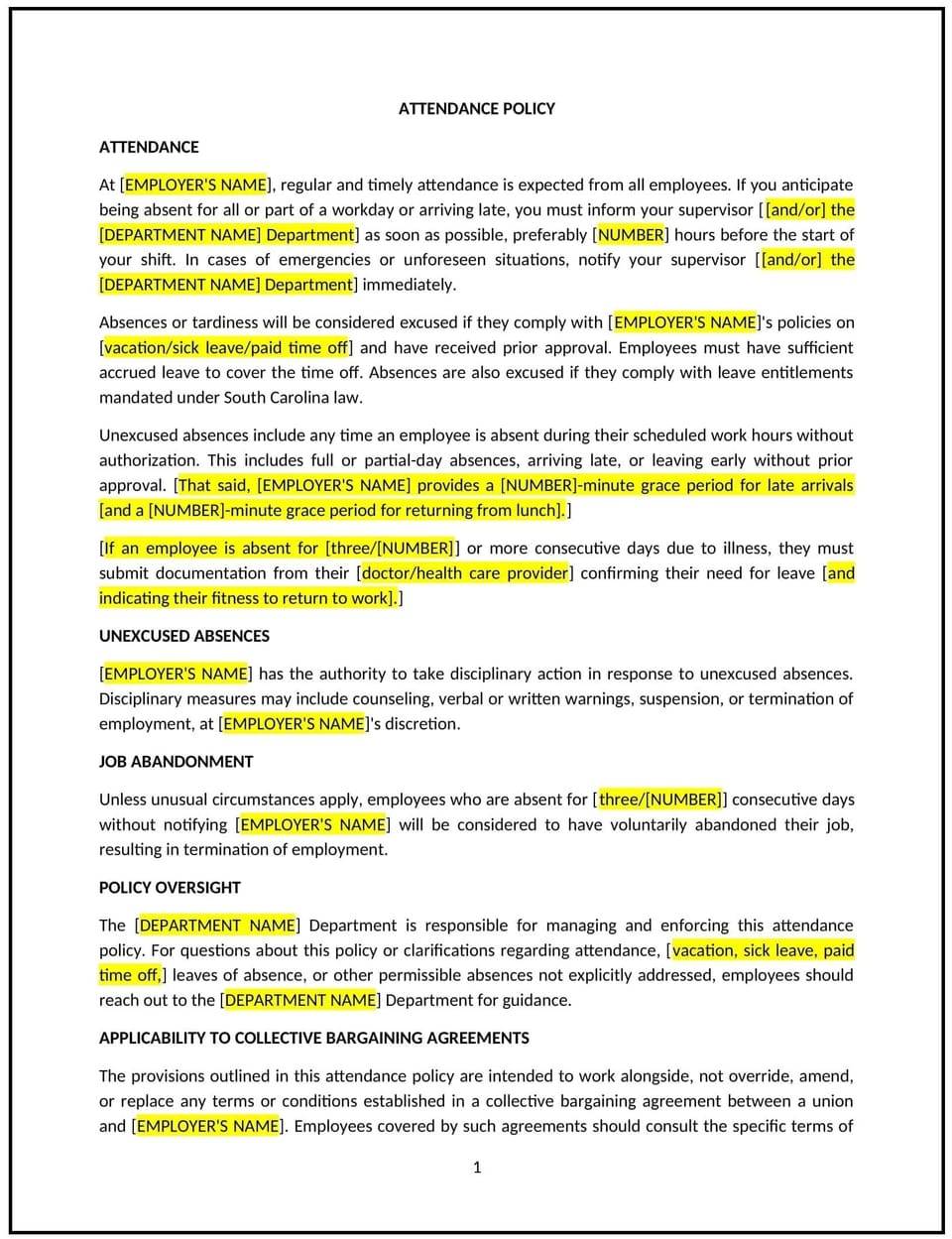Attendance policy (South Carolina): Free template

Attendance policy (South Carolina)
This attendance policy is designed to help South Carolina businesses establish guidelines for employee attendance, punctuality, and absenteeism. It outlines procedures for reporting absences, requesting time off, and addressing attendance issues.
By adopting this policy, businesses can maintain productivity, ensure fair treatment of employees, and align with general best practices for workforce management.
How to use this attendance policy (South Carolina)
- Define expectations: Specify work hours, punctuality requirements, and acceptable reasons for absences.
- Set reporting procedures: Provide steps for employees to report absences, including required notice and documentation.
- Address time-off requests: Outline procedures for requesting time off, such as vacation, sick leave, or personal days.
- Establish consequences: Explain the disciplinary actions for excessive absenteeism or tardiness, such as warnings or suspension.
- Train managers: Educate supervisors on enforcing the policy and addressing attendance issues fairly and consistently.
- Review and update: Assess the policy annually to ensure it aligns with evolving business needs and employee expectations.
Benefits of using this attendance policy (South Carolina)
This policy offers several advantages for South Carolina businesses:
- Maintains productivity: Ensures consistent attendance and minimizes disruptions to workflow.
- Promotes fairness: Provides clear guidelines for addressing attendance issues, ensuring consistent treatment of employees.
- Aligns with best practices: Demonstrates a commitment to effective workforce management.
- Enhances accountability: Encourages employees to take responsibility for their attendance and punctuality.
- Reduces absenteeism: Provides a framework for addressing excessive absences and improving attendance.
Tips for using this attendance policy (South Carolina)
- Communicate the policy: Share the policy with employees and include it in the employee handbook.
- Provide training: Educate managers on enforcing the policy and addressing attendance issues fairly and consistently.
- Monitor compliance: Regularly review attendance records to ensure adherence to the policy.
- Address issues promptly: Take corrective action if attendance problems persist or disrupt workflow.
- Update regularly: Review the policy annually to ensure it aligns with evolving business needs and employee expectations.
Q: How does this policy benefit businesses?
A: It maintains productivity, promotes fairness, and aligns with best practices for managing employee attendance.
Q: What should employees do if they need to take time off?
A: Employees should follow the outlined procedures for requesting time off, including providing required notice and documentation.
Q: Can businesses require documentation for absences?
A: Yes, businesses can require documentation, such as a doctor’s note, for certain types of absences, such as sick leave.
Q: What should businesses do if an employee has excessive absenteeism?
A: Businesses should follow the outlined disciplinary actions, such as issuing warnings or suspension, depending on the severity of the issue.
Q: How often should businesses review this policy?
A: Businesses should review the policy annually or as needed to ensure it aligns with evolving business needs and employee expectations.
This article contains general legal information and does not contain legal advice. Cobrief is not a law firm or a substitute for an attorney or law firm. The law is complex and changes often. For legal advice, please ask a lawyer.


